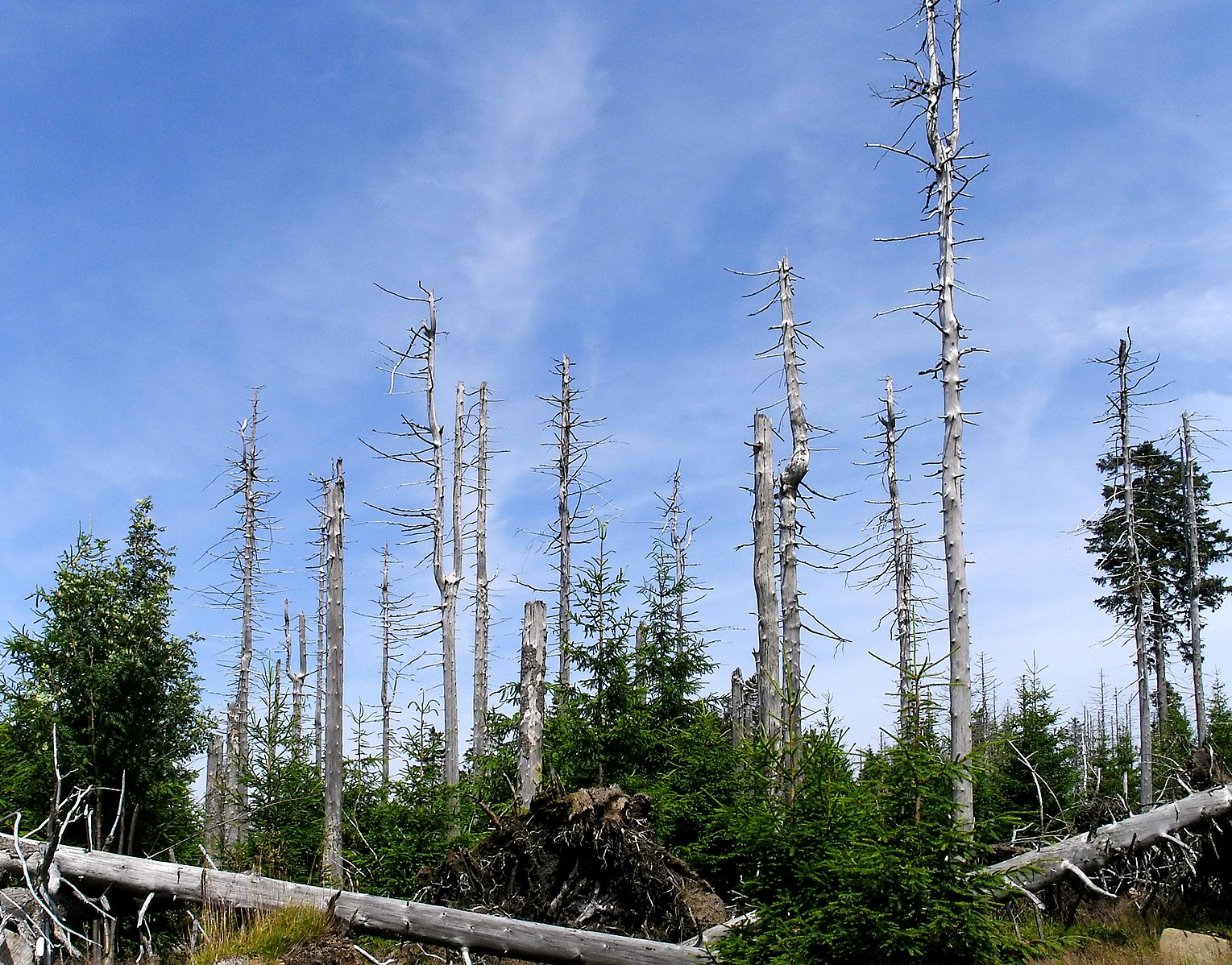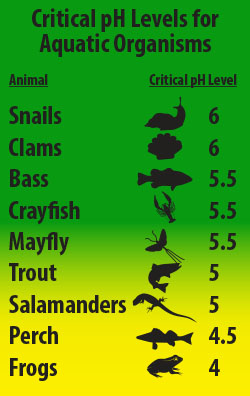IB Syllabus focus:
‘Acid deposition harms soils and foliage, mobilizes toxic aluminium in freshwaters, damages buildings and materials, and increases respiratory health risks.’
Acid rain has wide-ranging environmental and societal impacts, altering ecosystems, damaging infrastructure, and threatening human health. Understanding these consequences is essential for evaluating sustainability and policy responses.
Impacts on Soils
Acid deposition affects soil chemistry in multiple ways, reducing fertility and destabilising nutrient balances.
Leaching of nutrients: Essential ions such as calcium, magnesium, and potassium are washed out, lowering soil productivity.
Mobilisation of metals: Toxic metals like aluminium and heavy metals become more soluble in acidic conditions, contaminating groundwater and harming plant roots.
Reduced microbial activity: Soil bacteria and fungi are sensitive to pH changes, slowing down decomposition and nutrient cycling.
Leaching: The process by which soluble substances are removed from soil through the percolation of water.
This soil degradation diminishes agricultural yields and weakens natural vegetation growth, especially in sensitive forest ecosystems.
Effects on Vegetation
Plants suffer both direct and indirect damage from acid deposition.
Leaf injury: Acidic droplets can damage the waxy cuticle of leaves, reducing photosynthesis efficiency.
Root toxicity: Increased solubility of aluminium inhibits root development and nutrient uptake.
Forest decline: Long-term exposure leads to weakened trees, particularly at higher altitudes where acid rain concentrations are greater.
Forest decline: A gradual loss of tree health and growth caused by a combination of environmental stressors, including acid deposition.
Crops may also experience reduced productivity, affecting food security in regions exposed to prolonged acid rain.

Dead conifers alongside regenerating trees illustrate forest decline associated with acid deposition and nutrient depletion. Visual cues include extensive canopy loss and standing dead trunks in a high-elevation setting. The photograph shows impact patterns rather than specific chemical pathways (for example aluminium mobilisation). Source.
Impacts on Freshwater Ecosystems
Aquatic environments are especially vulnerable to acidification.
pH reduction in lakes and rivers: Many fish species cannot survive below pH 5, leading to biodiversity loss.

This graph shows the pH tolerances of common aquatic organisms and the loss of species as waters acidify. It supports the link between acid deposition, lower pH, and biodiversity decline in lakes and streams. Although aluminium mobilisation is discussed in the text, this figure focuses on pH tolerance rather than metal toxicity. Source.
Mobilisation of aluminium: Toxic aluminium ions enter waterways, clogging fish gills and causing suffocation.
Food web disruption: Acidification reduces plankton populations, destabilising food chains and reducing fishery yields.
In Scandinavia and North America, entire lake ecosystems have been devastated, demonstrating the severity of long-term acidification.
Damage to Buildings and Materials
Urban and cultural heritage sites are at risk from acid deposition.
Stone erosion: Limestone and marble, composed of calcium carbonate, react with sulphuric acid to form gypsum, which crumbles easily.

Acid deposition dissolves calcite in limestone and marble, smoothing edges and removing fine sculptural details. The roughened, pitted surface is typical of carbonate stone exposed to sulphuric and nitric acids. This visual complements the description of gypsum formation and accelerated weathering of monuments. Source.
Metal corrosion: Acid rain accelerates rusting of steel and iron, weakening bridges and infrastructure.
Cultural loss: Historic monuments and statues experience accelerated decay, particularly in regions with high industrial emissions.
Corrosion: The gradual destruction of materials, usually metals, through chemical reactions with their environment, often involving acids or oxygen.
This damage imposes significant economic costs for restoration and maintenance.
Human Health Impacts
While acid rain itself does not directly burn human skin, it contributes indirectly to health risks.
Respiratory issues: Acid rain forms from sulphur dioxide (SO₂) and nitrogen oxides (NOx), which also generate fine particulates. Inhalation increases risks of asthma, bronchitis, and lung cancer.
Drinking water contamination: Mobilised aluminium and heavy metals enter water supplies, increasing neurological and developmental risks in humans.
Ecosystem services decline: Reduced forest cover and soil fertility limit natural filtration of air and water, indirectly reducing health protections.
Particulates (PM2.5 and PM10): Small airborne particles with diameters less than 2.5 micrometres or 10 micrometres, capable of penetrating deep into the respiratory system.
Thus, acid deposition worsens air quality, particularly in urban-industrial areas.
Global and Regional Variations
The severity of impacts depends on local geology, industrialisation, and atmospheric conditions.
Regions with thin soils (e.g., Scandinavia, Canada) are more sensitive, as they lack buffering capacity.
Industrial regions (e.g., China, India) face higher deposition rates due to coal combustion.
Transboundary pollution: Winds carry SO₂ and NOx across national borders, making acid rain an international issue.
These variations highlight the interconnected nature of atmospheric pollution and the need for global cooperation.
Societal and Economic Costs
Beyond ecology and health, acid rain imposes significant financial burdens.
Loss of timber productivity in forestry.
Decline in fish stocks affecting commercial fishing.
Increased expenditure on repairing damaged infrastructure and monuments.
Higher healthcare costs linked to respiratory illnesses.
These costs highlight why acid rain is both an environmental and economic challenge, requiring integrated management strategies.
FAQ
When acid rain lowers the pH of soil and water, aluminium bound to clay minerals becomes soluble. This solubilised aluminium enters rivers and lakes, where it clogs fish gills and reduces oxygen uptake. Even at low concentrations, it can poison aquatic organisms and disrupt food chains.
High-altitude forests often receive more acidic precipitation because clouds and fog contain concentrated pollutants. These trees are already stressed by cold, thin soils, making them less resilient. The combination of nutrient leaching and direct leaf injury accelerates forest decline in such regions.
Limestone and marble: Dissolve readily due to their calcium carbonate composition.
Metals such as iron and steel: Corrode more quickly in acidic conditions.
Cultural monuments: Suffer detail loss, with fine carvings weathering fastest.
Protective coatings and regular maintenance can reduce damage, but costs are high.
Acid rain reduces forest cover and soil fertility, diminishing natural purification of air and water. Acidified lakes lose fish populations, undermining food sources. Contaminated groundwater, with dissolved metals, poses long-term risks to communities reliant on untreated supplies.
Sulphur dioxide and nitrogen oxides can travel hundreds of kilometres before forming acid rain. This means emissions in one country can damage ecosystems, infrastructure, and health in neighbouring nations. As a result, international agreements and regional cooperation are essential to address the problem effectively.
Practice Questions
Question 1 (2 marks)
State two impacts of acid deposition on freshwater ecosystems.
Mark Scheme:
Award 1 mark for each correct impact identified (maximum 2 marks).
Acceptable answers include:
Reduction of pH leading to species loss.
Mobilisation of toxic aluminium harming fish.
Decline in plankton or disruption of aquatic food webs.
Reduced fishery yields.
Question 2 (5 marks)
Explain how acid deposition impacts both natural ecosystems and human society.
Mark Scheme:
Award up to 3 marks for impacts on ecosystems.
1 mark: Nutrient leaching in soils / reduced soil fertility.
1 mark: Forest decline or damage to vegetation.
1 mark: Loss of aquatic biodiversity due to lower pH and aluminium toxicity.
Award up to 2 marks for impacts on human society.
1 mark: Damage to buildings and monuments (stone erosion, corrosion of metals).
1 mark: Human health risks through respiratory illnesses or contaminated drinking water.
Answers should show clear linkage between acid deposition and the stated impacts to gain credit. Partial explanations with vague references gain only 1 mark each.

